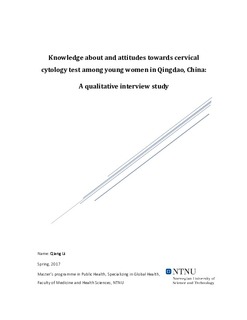| dc.description.abstract | Background: Cervical cancer is the third most common cancer among women worldwide. It is one of the leading types of cancer in China. According to the Chinese National Health and Family Planning Commission, 130,000 new cases would be estimated every year and 30,000 women would die from the disease. There has also been a significant increase among Chinese women below 35 years old. Despite the cervical cytology test has been considered as an effective method to prevent the cancer, some previous studies showed that only one in five women in China reported ever having had a cervical cytology test.
Aims: • to explore young Chinese women’s general knowledge about and attitudes towards taking a cervical cytology test in cervical screening, and • to explore their thoughts about potential improvements of information and services of cervical screening
Method: It was a qualitative study in which semi-structured individual interviews were conducted in a mid-sized city called Qingdao in the east of China. 17 women aged between 21 to 36 participants took part in the study. The data was analysed based on Systematic Text Condensation (STC) in order to describe the participants’ experience.
Results: The findings in the current study showed that most of the participants did not have adequate knowledge about the cervical cancer and the cervical cytology test. Cultural factors, such as feelings of embarrassment and assumption of low-level risk, had a significant impact on the participants’ acceptance of receiving a cervical cytology test, especially among unmarried participants. The inconvenience of obtaining the cervical screening service was considered as another obstacle. In order to raise the awareness in the future, several suggestions were given by the participants, such as getting the health professionals involved and maximizing the utility of the internet.
Conclusion: The presented study suggested some possible reasons of low attendance rate of cervical cytology test in China. It has highlighted an urgent need to improve the knowledge about cervical cancer and cervical cytology test among Chinese young women. The service should become more accessible to both married and unmarried women. Cooperation among the local government, communities and health service providers is required in order to divert the flow of the patients from the large hospitals. Interventions from communities are also needed to ensure these women receive cervical cytology test on regular basis and follow-up takes place if the test is abnormal. | nb_NO |
